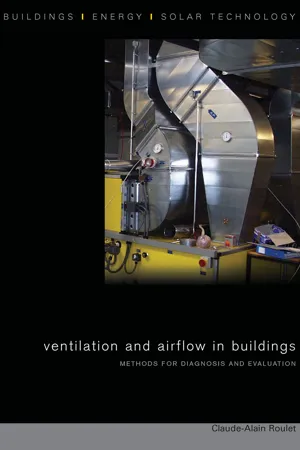![]()
1
Airflow Rates in Buildings
This chapter intends to help the reader to measure airflow rates and air change rates in buildings and rooms, independently of a mechanical ventilation system. It presents the techniques used to measure the airflow rate entering the measured zone (single-zone measurements) and to measure inter-zone airflows (multi-zone measurements).
A building zone or a zone is a space that can be considered as homogeneous from the point of view of air quality or, more technically, a space in which each tracer gas is homogeneously distributed. In practice, it is a room or a set of adjacent rooms that have much larger airflow rates between them than to or from other zones or the outdoor space.
The measurement techniques presented here are all based on the use of tracer gases that are injected into the air and analysed in air samples after mixing. More detailed information on the tracer gases themselves, on appropriate injection and sampling methods and on tracer gas analysers is given in Chapter 7, ‘Tracer gas dilution techniques’.
Single-zone measurements
The tracer gas is injected in a space, mixed into the air and its concentration is measured. Various strategies can be used for assessing the airflow rate entering the space: recording and interpreting the concentration decay after having stopped the injection, monitoring the tracer gas concentration when injecting the gas at constant rate, or measuring the tracer gas flow rate required for keeping its concentration constant. Airflow rates are obtained by interpreting the evolution with time of either the tracer gas concentration or the injection rate. The interpretation methods are based on the mass conservation of tracer gas and of the air.
Mass conservation of tracer gas and air
The tracer gas injected in a building space is uniformly mixed into the air. The conservation of the mass of tracer gas within a single zone in contact with the outdoor environment is then:
where:
m | is the mass of tracer gas in the zone (kg); |
I | is the injection rate of the tracer gas (kg/s); |
C | is the tracer gas mass concentration; |
Q | is the mass airflow rate (for example, Qio is airflow rate from indoor to outdoors); |
i | subscript for internal environment; |
o | subscript for external environment. |
In addition, the conservation of the mass of air gives:
The mass of tracer in the zone is related to the mass of air M by:
where Ci is the concentration of the tracer gas in the indoor air. Combining the last three equations, we get:
since M is very close to a constant if the temperature is constant. In principle, this equation can directly provide the airflow rate:
writing ΔC = Ci – Co.
This method is, however, very inaccurate, since very quickly the concentration may vary at random because of turbulence and non-homogeneities. It is therefore better to take a time average by integrating it for a given period of time:
hence:
or, dividing both members by Δt
where the quantity between brackets 〈〉 is averaged over the time period Δt.
This solution can be simplified, depending on the way the tracer is injected.
Tracer decay, no injection
A suitable quantity of tracer gas is injected to achieve a measurable initial concentration Ci,0. At time t0, this injection is stopped and I = 0 afterwards. From Equation 1.4, it can be found that the concentration decays with time according to:
The quantity
is called the nominal time constant of the measured zone. It is the ratio of the mass of air contained in the zone to the mass airflow rate. It is also the time needed to introduce a mass of new air equal to that contained in the zone.
Since I = 0, Equation 1.8 becomes:
This equation allows easy calculation of the airflow rate from the measurement of concentration at two instants. This method is called the decay method. It is a direct measurement of the nominal time constant, and also provides an unbiased estimate of the mean airflow rate.
Constant injection rate
If the injection rate is constant, the solution of Equation 1.4 is:
Using identification technique (see Chapter 7 ‘Identification methods’), both τn and Qio (hence also M) can be obtained. This method is, however, of easy use only when Qio is constant. In this case, the exponential term becomes negligible after three or more time constants, and
or
The result is biased (underestimated) if the airflow rate is not constant.
Constant concentration
Using an electronic mass flow controller monitored by the tracer gas analyser, the concentration of tracer gas can be maintained constant by varying the injectio...














